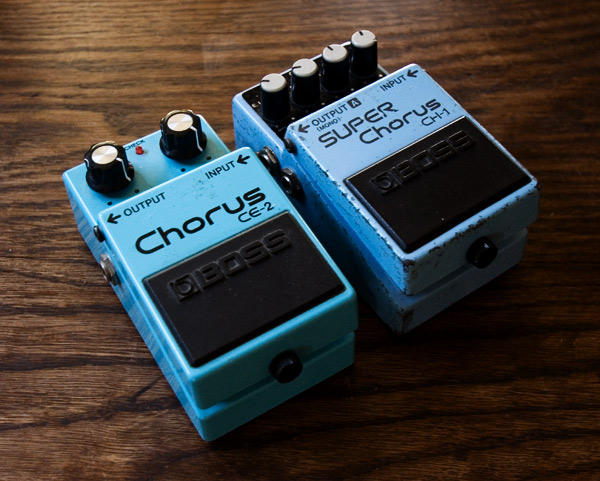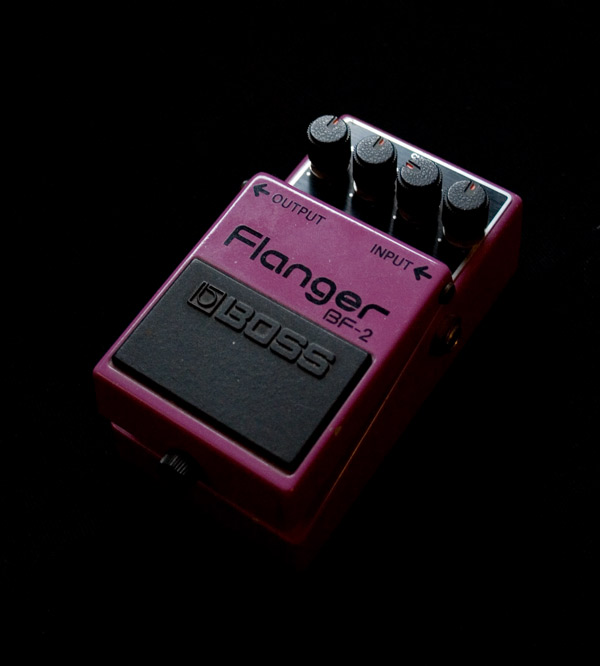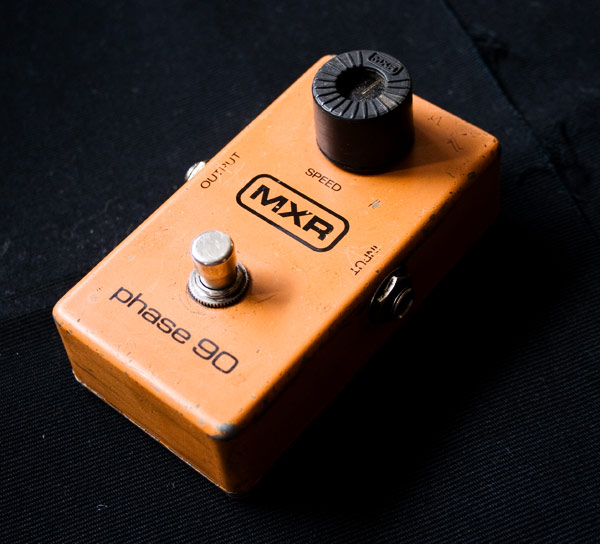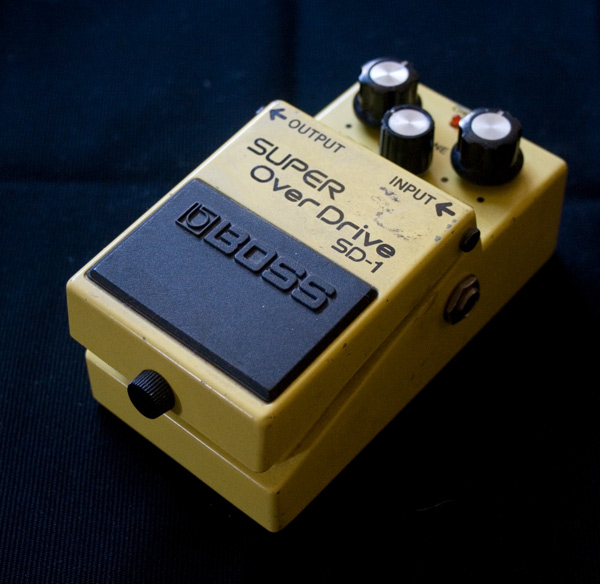After the Phaser and the Flanger, part 3 of this series of posts dedicated to modulation effects will focus on the Chorus. Used and abused with clean tones in the eighties, it seemed to have lost its popularity in the early nineties but it remains a classic. I have prepared a few videos to show you how useful a Chorus is for clean and distorted tones. I have used for this purpose my “modern” Boss CH-1 as well as my vintage Boss CE-2. You will find at the end of this post a short selection of chorus pedals.

Origins
The Chorus effect occurs in the real world when two musicians (or singers) play the same piece in unison. Because the two don’t have exactly the same pitch and timbre, it creates a “choir” effect. Electronically, the effect is produced by mixing the incoming signal with a slightly delayed and detuned copy of itself. The pitch difference is modulated to create oscillations.
What is the difference with a Flanger then? One of the chief differences (but not the only one) is that the delay time on Flangers is shorter than it is on Choruses. Flangers have a “jet plane” type of sound but Chorus pedals don’t. Nevertheless, Flangers and Choruses can sound similar depending on how they are set.
Back to the Eighties
The first acknowledged chorus pedal is the Boss CE-1, released in 1976. It actually started the Boss brand, a subdivision of Roland. Somehow, it sounded so cool that everybody started using it. When the eighties arrived, every guitarist in almost any genre had to have a chorus pedal in their arsenal. It was a must for clean tones as it made them sound fatter, akin to a twelve string guitar. Andy Summers of The Police is a known user of the Boss CE-1 and you can hear its chime in a lot of The Police records. But the use of Chorus was not limited to pop, it was also used in rock, funk and jazz.
Actually, the Boss CE-1 is based on the integrated Chorus circuit of a Roland amplifier which is still a reference amongst transistor based guitar amplifiers: the JC-120 aka Jazz Chorus 120. It is fitted with an integrated stereo chorus effect. This amp was used by countless artists and not only in Jazz, Robert Smith of The Cure as well as Joe Satriani used it at some stage in their careers.
Setting Knobs and Placement in the Effect Chain
Most Chorus pedals have at least two settings: Depth and Rate. The Depth setting controls the intensity whereas the Rate setting controls the speed of the oscillation (the amount of swirling). The Boss CH-1 that I feature in the videos below has another two settings which are quite rare on most chorus pedals: MIX to control the amount of direct sound and chorused sound and EQ which controls the brightness of the effect.
When it comes to placing your chorus in your effect chain, it is usually recommended to place it after your distortion or overdrive (or in the effect loop of your amp). Nevertheless, it is also usable before a distortion/overdrive, the effect will be less “precise”.
Using a Chorus with Clean Tones
It is quite important to realize that some chorus pedals are really warm sounding whereas others are more transparent. If you are looking to emulate the sound of Kurt Cobain in the intro of “come as you are”, forget about using a pretty transparent chorus pedal, you need the dirty analog type (for the record, he used an Electro Harmonix Small Clone). Some guitarists hate that type of very fat chorus and prefer the transparent type.
In that respect, the two pedals I am using in the videos below represent quite well these two types of tones: the CE-2 is warm and fat while the CH-1 is pretty and transparent unless you really push it. Also note that the CE-2 is mono whereas the CH-1 can be used in stereo.
I show here mild as well as extreme settings with both my BOSS CE-2 and BOSS CH-1. My basic tone features some compression courtesy of an MXR Dynacomp. Note how I have to put the level fairly high on the CH-1 to get a pronounced chorus effect.
Gear used for the demo besides chorus pedals: 1978 Fender Telecaster with stock pickups, MXR dynacomp (OUTPUT at 3 o’clock, SENSITIVITY at 9 o’clock), 1974 Fender Champ. Some compression and reverb were added in Cubase.
Using a Chorus with a Distorted/Overdrive tone
Putting a chorus after a rather distorted tone will transport you back to the shredders of the eighties. Not all of them used a chorus for their lead tone but some definitely did.
I personally prefer to use a transparent Boss CH-1 with distorted tones rather than a CE-2 but it really is a matter of preference. What I like is that the CH-1 has a Depth as well as a Level control. I like to back down the Level on distorted tones. I show in this video how the Level knob affect your tone:
Gear used for this demo besides chorus pedals: Custom Made guitar by Robin Bully, bolt on neck equipped with Schaller Pickups (Golden 50 in the bridge position), Analogman TS-9, Analogman DS-1 and Fender Champ. Some eq, compression and reverb were added in Cubase. I used a graphic equalizer to scoop the midrange and get a more “metal” tone out of my Fender amp (more on this in another post).
Chorus pedal selection
- Boss CE-5, CH-1 and CE-20: with these three models, Boss covers the whole spectrum of chorus sounds. The CE-5 is the last in the CE line, the CH-1 is probably more transparent. As to the CE-20, it is a sophisticated digital modeling pedal that can emulate the sound of different models including the CE-1. All these pedals are stereo.
- Electro Harmonix Small Clone: the sound of Kurt Cobain on “Come as you are”, analog and fat.
- Line 6 Space Chorus: a digital pedal that I had the chance to try. Very versatile, I especially like the “Tri Chorus” emulation which is based on a rare 80s unit.
- Ibanez CS-9: a stereo analog pedal, it is a reissue of an 80s classic.
- MXR Micro Chorus: recently re-issued, it is a simple and small one button pedal which offers a lot more different sounds than you would think.
- Retro Sonic chorus: Retro Sonic has made a specialty of recreating classic models. Their chorus is a faithful recreation on the Roland/Boss CE-1 in a more compact form.
- Analogman Chorus: the father of all boutique manufacturers offers some popular and tasty analog chorus pedals.
A note about stereo chorus pedals: In order to use this capability efficiently with the guitar, you need two amplifiers, a stereo amp (quite rare) or a stereo rack system.



